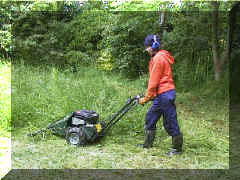|
Early Year 1 to 3
Establishment and
Maintenance
Seedling
establishment phase When you first sow a meadow, seedlings
will keep on germinating each spring and autumn until about the second
or third year. This is when
maintenance is required, after the meadow is established your job is to
manage it with one cut per year, some customers on fertile soil have
to wait up to seven years for fertility to drop, and must maintain
it fully as if in years two to three.
Correct timing when cutting the
meadow is crucial to the survival of seedlings.
A meadow is won or lost at this stage. If your original cultivation
methods did not produce a clean weed-free seedbed, this is your last
chance to get rid of stones and weeds that you have missed.
During this stage it is vital that you cut and remove the growth of
grasses & flowers, each autumn. Cutting the growth away allows the
sun to warm the soil and for fresh air to circulate over the tiny
seedlings. If the grass is left uncut, mould will grow and kill off the
tiny seedlings. Remove the dead layer of thatch at the base of grasses.
Use a rake, a spring tine rake, a rotavator set high with only a few
light passes to scratch the soil, or drag a chaim, chain harrow or
harrow over the surface to scratch it.
For dry areas roll the seed bed when
there is no sign of germination, it helps to break the soil surface,
(Must be dry).
On large dry areas roll with any
roller if the soil is dry crusted. but try use a Cambridge type
ridged roller it is at all damp.
Any meadow can be cut every 30-60 days to
keep tidy as a lawn. (topping)
On infertile sites cutting may not be necessary,
except once in the autumn.
On very barren sites you may not have to cut
at all, instead roll with a Cambridge roller.
The seedling establishment stage must be maintained during the first
year and may need to continue into the 2nd and 3rd year on fertile
sites. See also 'Gap creation'.
Meadow
cutting times in the 'first and second year' both 'with' and 'with out
grass'.
Meadow
cutting times 'without grass'
Most annuals and pure wildflowers sown 'without
grass' need only be cut when flowers fade in autumn. For 'non-grass' mixtures
of pure wildflowers, cut and remove if growth passes a height of 25-35 cm by
mid June as the meadow is growing too fast. Cut again in August or when
annual flowers finish.
Spring flowering wetland meadows can be cut in late May to restrict
Creeping Buttercup setting seed.
Meadow
cutting times 'with grass'
In the first year for meadows sown
'with grass' always cut by the end of July if not sooner.
All floras sown with grass and without annuals must be regularly cut and
the grass removed when growth passes a height of 15-25cm in the first
year. Cut down to 2"-4".
The grass must not 'lodge' (fall over). On fertile sites
where grass seed is mixed in wildflower mixtures from 2, 3, 4, - 6 cuts per year may be required to reduce
fertility during the seedling establishment phase. top the grass and
remove it if you can, failing that dont leave clumps about, and the
meadows last cut per year, will require, a full clean up, remove all
dead grass and rake up, remove the fertility in cutting the grass away.
Allow those tiny seedlings a fighting chance and our mixture will perform
far better.
Special
Cutting Times to attract wildlife or encourage specific plant species
Some wildflower meadows are recommended
as requires special cutting times. This advice is given to encourage
specific flowers, flora types or to attract wildlife. Where such advice
is given, if the wildflower grower seeks to follow our instructions, it
is hoped that the result will be rewarding. We have established many
wonderful floras for customers, keep at it until it becomes fully
established, send us photos please.
Typical Specific cutting times may
include, advice such as: "Dear Customer. Cut in
High Summer when meadow is in full flower, Why? because in your photo i can
see spring flowers such as Cowslip, Ragged Robin and Red Campion and late summer
seedlings of flowering
species such as Fleabane and Devil's Bit Scabious. So please cut it
early, as the meadow would only grow grassy if left uncut. As along with
the creeping buttercup I can see a lot of wild grass seedlings. So the advice given is to cut
the meadow which may well be flowering or about too in late May, after the Red Campion or
other spring flowers finish blooming and have set seed. The cut will
only knock back the summer flowers especially the dog daisy and rearrange the meadow for a later summer or
High Summer bloom, which will allow the later flowering species mentioned
about to grow and
set seed."

Cutting
Machinery Use a
strimmer with blade attachment or a finger / sickle bar mower ( lawn
mower Type) Use scythes, shears, tractor mowers, finger mowers,
flail mowers, disc cutters, mowing bars
There are far too many variations of advice,
so all I can say is read the specifications and advice supplied with every
seed mixture
We remove all dead
grass because it rots down and make soil more fertile. Bare soil and
allows ultra violet sun light to sterilise the soil, so that new
seedlings grow in mould free environment. Sunlight discourages
slugs and slug eggs and having little decaying/dead thatch allows birds
to scratch the soil.
Return
to Index - Wildflower Growers Manual
|